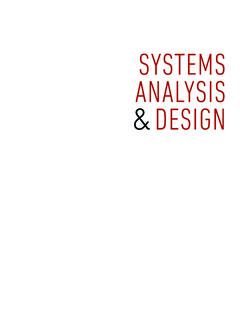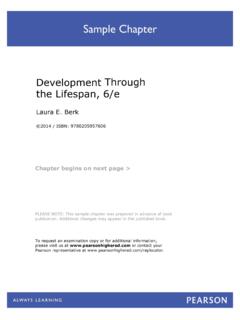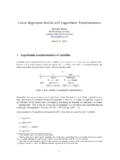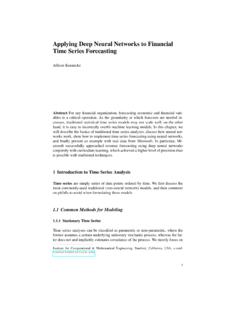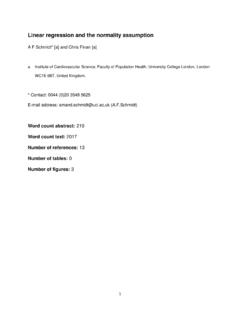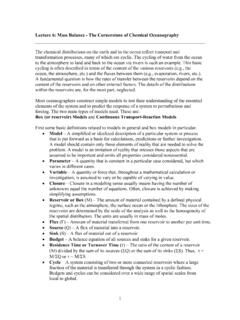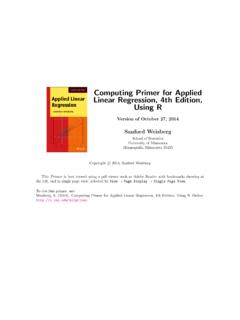Transcription of Chapter 7: Modeling Relationships of Multiple Variables ...
1 Chapter 7: Modeling Relationships of Multiple Variables with Linear Regression Overview Chapters 5 and 6 examined methods to test Relationships between two Variables . Many research projects, however, require analyses to test the Relationships of Multiple independent Variables with a dependent variable . This Chapter describes why researchers use Modeling and then examines one of the most powerful Modeling approaches: linear regression. We show how to interpret regression statistics and graph linear regressions using the STATES10 data. Finally, we discuss issues related to data structures and model building. The Advantages of Modeling Relationships in Multiple Regression In most studies, building Multiple regression models is the final stage of data analysis. These models can contain many Variables that operate independently, or in concert with one another, to explain variation in the dependent variable .
2 For example, as we discussed in previous chapters, both gender and education status can predict when a person has a child. Using Multiple regression can help a researcher understand, for example, the association between education status and age of having a first born child above and beyond the influence of gender. It can also be used to understand how much of the variation in the age of having a first born child can be explained by the combination of those two factors. However, before one begins a Multiple regression, it is critical to follow the stages of analysis already presented in the previous chapters. In the first stage, researchers use univariate analyses to understand structures and distributions of Variables , as these can affect the choice of what types of models to create and how to interpret the output of those models. In the second stage, researchers use bivariate analyses to understand Relationships between variable pairs.
3 These Relationships can disappear or emerge in new and sometimes unexpected ways once Chapter 7 Modeling Relationships of Multiple Variables with Linear Regression 162 all the Variables are considered together in one model. In some circumstances, the emergence and disappearance of Relationships can indicate important findings that result from the Multiple variable models. But alternately, disparate results could indicate fragilities in the models themselves. As we discuss later in this Chapter , a core concern in regression analysis is creating robust models that satisfy both mathematical and theoretical assumptions. A firm understanding of the data at the individual and bivariate levels is critical to satisfying this goal. Before discussing model building and the application of Multiple linear regression, let us first take a step back and reflect on the reasons why they are needed.
4 Suppose, for example, that a researcher is interested in predicting academic success, a construct that she operationalizes as grade point averages (GPAs). After determining that GPAs are approximately normally distributed, she performs a series of bivariate analyses that reveal the following sets of Relationships : Women have higher GPAs than men Length of time spent studying is positively associated with GPAs Students who are members of fraternities have the same GPAs as non members Students who are in sport teams have lower GPAs than non-athletes Sophomores, juniors, and seniors have higher GPAs than freshmen Students who drink heavily have lower GPAs than light drinkers and abstainers These are interesting findings, but they open new questions. For example, do freshman and athletes receive lower grades because they study less? Are the GPAs of men pulled downward because they are more likely to be members of sports teams?
5 Can the differences between the performances of men and women be attributed to men drinking more heavily? Answering these types of questions requires considering not only the Relationships between the dependent variable (GPA) and individual independent Variables (gender, drinking, sports, etc.), but also the constellation of Variables that correspond with being a student. One of the great benefits of regression analysis is its ability to document collective effects - the interplay among factors on predicted outcomes. For instance, regression models can predict the expected GPAs based on combinations of Variables as they may be configured in the lives of individuals ( , a non-drinking, female, athlete). They also can measure the amount of variation in the dependent variable that can be attributed to the Variables in the model, and conversely, how much of the variation is left unexplained.
6 In the case of GPAs, a regression model can tell the strength of the six factors in predicting academic success. Do these factors account for many of the differences among students, or only a small fraction of the differences? Regression models measure explanatory power, and how well predictions of social behavior correspond with observations of social behavior. Additionally, Multiple regression models are critical to accounting for the potential impact of spurious Relationships . Recall from Chapter 1 that a spurious relationship occurs when a third variable creates the appearance of relationship between two other Variables , but this relationship disappears when that third variable is included in the analysis. Using the example above, perhaps the differences in performances of athletes and non-athletes may simply be the result of athletes spending less time studying.
7 If the negative association of athletics to GPA disappears when studying is taken into account, it leads to a Chapter 7 Modeling Relationships of Multiple Variables with Linear Regression 163 more sophisticated understanding of social behavior, and more informed policy recommendations. Finally, one of the great advantages of mulitple regression models is that they allow for the inclusion of control Variables . Control Variables not only help researchers account for spurious Relationships , they measure the impact of any given variable above and beyond the effects of other Variables . For example, a researcher could document the influence of drinking on GPAs adjusting for the impact of gender, sports, fraternities, and time spent studying. Or consider the relationship between gender and GPA. Suppose the relationship between gender and GPA disappears after taking into account all of the other Variables in the model.
8 What would that suggest about theories that posit innate differences in abilities to succeed in college? Putting Theory First - When to Pursue Linear Regression Later in this Chapter we consider some mathematical principles and assumptions that underpin linear regression. But first we consider some theoretical issues critical to its application. Linear regressions are designed to measure one specific type of relationship between Variables : those that take linear form. The theoretical assumption is that for every one-unit change in the independent variable , there will be a consistent and uniform change in the dependent variable . Perhaps one reason why linear regression is so popular is that this is a fairly easy way to conceive of social behavior if more of one thing is added, the other thing will increase or decrease proportionately. Many Relationships do operate this way.
9 More calories results in proportional weight gains, more education results in proportionally higher earnings, etc. In our example above, a linear model assumes that that each additional hour a student spends studying (whether the increase is from 5 to 6 hours a day, or from 1 to 2 hours a day) the incremental effect on the GPA will be constant. This may be true, but it also may not. Recall the discussion in Chapter 5, that there are many types of Relationships between Variables . For example, students who experience little anxiety and those who experience excessive anxiety tend to perform more poorly on exams than students who score midrange in an anxiety scale (these individuals are very alert, but not overwhelmed). Because this inverted U shaped relationship is nonlinear, the application of linear techniques will make it appear non-existent. Or consider another example - the impact of class size on academic performance.
10 It is generally understood that a negative relationship exists between class size and academic performance the smaller the class the more students benefit. However, changing a class from 25 students to 20 students will have almost no effect on student performance. In contrast, the same increment of change from 12 to 7 students can have a much more substantial change in classroom The same 5-student difference in class size has different effects, depending on where the incremental change is located . Conversely, there may be positive effects of time spent studying on GPA, but the benefits of each additional hour may be smaller once a sufficient amount of study time is reached. 18 This type of logarithmic relationship can still be tested using linear regression techniques, but it requires transforming data so that the model corresponds to the way the data are actually configured.







